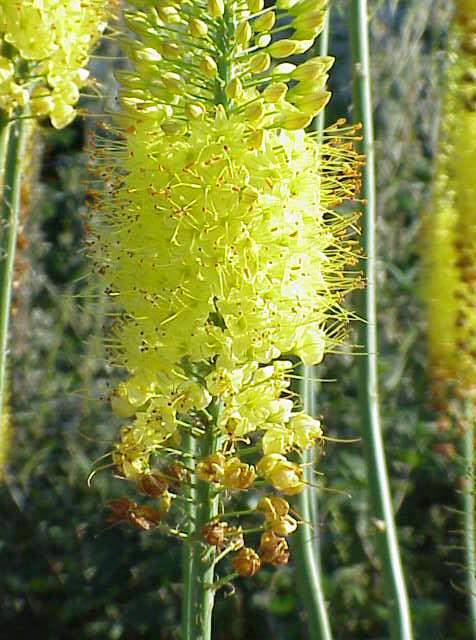|
Kumara Haemanthifolia
''Kumara haemanthifolia'' is a species of flowering plant in the family Asphodelaceae. It is a rare species of succulent plant, native to a few high, inaccessible mountain peaks in the Fynbos habitat of Western Cape, South Africa. Description ''Kumara haemanthifolia'' is a small bunched plant, related to aloes, with greyish-green, tongue-shaped leaves that grow in a fan shape, similar to its sister species ''Kumara plicatilis'', the fan-aloe. In fact, it looks very much like a diminutive, stemless form of the tree-like ''Kumara plicatilis''. Its compact ranks of leaves are oblong and grey-green in colour, with bright red margins. Small and close to the ground, it often escapes notice or is mistaken for a lily. In fact, its name "''haemanthifolia''" was given because of its resemblance to the popular ''Haemanthus'' bulbs. It produces bright scarlet flowers at the end of winter (September up until November in its natural habitat). Distribution Its natural range also nearly matc ... [...More Info...] [...Related Items...] OR: [Wikipedia] [Google] [Baidu] |
Rudolf Marloth
Hermann Wilhelm Rudolf Marloth (28 December 1855 Lübben, Germany – 15 May 1931 Caledon, Cape Province) was a German-born South African botanist, pharmacist and analytical chemist, best known for his ''Flora of South Africa'' which appeared in six superbly illustrated volumes between 1913 and 1932. This botanist is denoted by the author abbreviation when citing a botanical name. Biography Early life Marloth studied pharmacy in Lübben from 1873-1876. after which he worked at various pharmacies in Germany and Switzerland, then formally qualified as a pharmacist at the University of Berlin. In 1883 he was awarded a doctorate for his thesis "''The protective mechanisms employed by seeds against harmful agents''". He arrived in Cape Town on 30 December 1883 after being urged to do so by a schoolfriend who had already settled there. During his first year there he worked as a pharmacist for the firm of Wentzel and Schleswig. He was enthralled by Cape Town and Table Mountain and ... [...More Info...] [...Related Items...] OR: [Wikipedia] [Google] [Baidu] |
Stellenbosch
Stellenbosch (; )A Universal Pronouncing Gazetteer. Thomas Baldwin, 1852. Philadelphia: Lippincott, Grambo & Co.A Grammar of Afrikaans. Bruce C. Donaldson. 1993. Berlin: Walter de Gruyter. is a town in the Western Cape province of South Africa, situated about east of Cape Town, along the banks of the Eerste River at the foot of the Stellenbosch Mountain. The town became known as the City of Oaks or ''Eikestad'' in Afrikaans and Dutch language, Dutch due to the large number of oak trees that were planted by its founder, Simon van der S ... [...More Info...] [...Related Items...] OR: [Wikipedia] [Google] [Baidu] |
IUCN Red List Critically Endangered Species
Version 2014.2 of the IUCN Red List of Threatened Species identified 4574 Critically Endangered species, subspecies and varieties, stocks and subpopulations. For IUCN lists of critically endangered species by kingdom, see: *Animals (kingdom Animalia) — IUCN Red List Critically Endangered species (Animalia) **Amphibians — List of critically endangered amphibians **Birds — List of critically endangered birds **Fish — List of critically endangered fishes **Invertebrates — List of critically endangered invertebrates ***Arthropods — List of critically endangered arthropods ****Insects — List of critically endangered insects ***Molluscs List of critically endangered molluscs **Mammals — List of critically endangered mammals **Reptiles — List of critically endangered reptiles *Fungi (kingdom Fungi) — List of fungi by conservation status *Plants (kingdom Plantae) — List of critically endangered plants *Protists (kingdom Protista) — List of Chromista by c ... [...More Info...] [...Related Items...] OR: [Wikipedia] [Google] [Baidu] |
Flora Of The Cape Provinces
Flora is all the plant life present in a particular region or time, generally the naturally occurring (indigenous) native plants. Sometimes bacteria and fungi are also referred to as flora, as in the terms '' gut flora'' or '' skin flora''. Etymology The word "flora" comes from the Latin name of Flora, the goddess of plants, flowers, and fertility in Roman mythology. The technical term "flora" is then derived from a metonymy of this goddess at the end of the sixteenth century. It was first used in poetry to denote the natural vegetation of an area, but soon also assumed the meaning of a work cataloguing such vegetation. Moreover, "Flora" was used to refer to the flowers of an artificial garden in the seventeenth century. The distinction between vegetation (the general appearance of a community) and flora (the taxonomic composition of a community) was first made by Jules Thurmann (1849). Prior to this, the two terms were used indiscriminately.Thurmann, J. (1849). ''Essai de ... [...More Info...] [...Related Items...] OR: [Wikipedia] [Google] [Baidu] |
Endemic Flora Of South Africa
Endemism is the state of a species being found in a single defined geographic location, such as an island, state, nation, country or other defined zone; organisms that are indigenous to a place are not endemic to it if they are also found elsewhere. For example, the Cape sugarbird is found exclusively in southwestern South Africa and is therefore said to be ''endemic'' to that particular part of the world. An endemic species can be also be referred to as an ''endemism'' or in scientific literature as an ''endemite''. For example '' Cytisus aeolicus'' is an endemite of the Italian flora. '' Adzharia renschi'' was once believed to be an endemite of the Caucasus, but it was later discovered to be a non-indigenous species from South America belonging to a different genus. The extreme opposite of an endemic species is one with a cosmopolitan distribution, having a global or widespread range. A rare alternative term for a species that is endemic is "precinctive", which applies to ... [...More Info...] [...Related Items...] OR: [Wikipedia] [Google] [Baidu] |
Asphodeloideae
Asphodeloideae is a subfamily of the monocot family Asphodelaceae in the order Asparagales. It has previously been treated as a separate family, Asphodelaceae ''sensu stricto''. The family Asphodelaceae has now been proposed to be a nomen conservandum, and the proposal has been recommended for ratification in 2017. In that case, Asphodelaceae will have priority over Xanthorrhoeaceae. This is reflected in the APG IV family lists. The subfamily name is derived from the generic name of the type genus, ''Asphodelus''. Members of group are native to Africa, central and western Europe, the Mediterranean basin, Central Asia and Australia, with one genus ('' Bulbinella'') having some of its species in New Zealand. The greatest diversity occurs in South Africa. The genera ''Aloe'', ''Asphodelus'', and ''Kniphofia'' are perhaps best known from their use in horticulture as ornamental plants. Description The Asphodeloideae are distinguished by a general presence of anthraquinones, s ... [...More Info...] [...Related Items...] OR: [Wikipedia] [Google] [Baidu] |
Royal Botanic Gardens, Kew
Royal Botanic Gardens, Kew is a non-departmental public body in the United Kingdom sponsored by the Department for Environment, Food and Rural Affairs. An internationally important botanical research and education institution, it employs 1,100 staff. Its board of trustees is chaired by Dame Amelia Fawcett. The organisation manages botanic gardens at Kew in Richmond upon Thames in south-west London, and at Wakehurst, a National Trust property in Sussex which is home to the internationally important Millennium Seed Bank, whose scientists work with partner organisations in more than 95 countries. Kew, jointly with the Forestry Commission, founded Bedgebury National Pinetum in Kent in 1923, specialising in growing conifers. In 1994, the Castle Howard Arboretum Trust, which runs the Yorkshire Arboretum, was formed as a partnership between Kew and the Castle Howard Estate. In 2019, the organisation had 2,316,699 public visitors at Kew, and 312,813 at Wakehurst. Its site at Kew ... [...More Info...] [...Related Items...] OR: [Wikipedia] [Google] [Baidu] |
World Checklist Of Selected Plant Families
The World Checklist of Selected Plant Families (usually abbreviated to WCSP) is an "international collaborative programme that provides the latest peer reviewed and published opinions on the accepted scientific names and synonyms of selected plant families." Maintained by the Royal Botanic Gardens, Kew, it is available online, allowing searches for the names of families, genera and species, as well as the ability to create checklists. The project traces its history to work done in the 1990s by Kew researcher Rafaël Govaerts on a checklist of the genus ''Quercus''. Influenced by the Global Strategy for Plant Conservation, the project expanded. , 173 families of seed plants were included. Coverage of monocotyledon families is complete; other families are being added. There is a complementary project called the International Plant Names Index (IPNI), in which Kew is also involved. The IPNI aims to provide details of publication and does not aim to determine which are accepted spec ... [...More Info...] [...Related Items...] OR: [Wikipedia] [Google] [Baidu] |
:Category:Fynbos
*The Fynbos ecoregion — of the Mediterranean forests, woodlands, and scrub Mediterranean forests, woodlands, and scrub is a biome defined by the World Wide Fund for Nature. The biome is generally characterized by dry summers and rainy winters, although in some areas rainfall may be uniform. Summers are typically hot in ... Biome, located in southwestern South Africa. *''The endemic vegetation habitat type and plant community is unique to the Western Cape.'' {{catmain, Fynbos Mediterranean forests, woodlands, and scrub Ecoregions of South Africa Flora of the Cape Provinces Geography of South Africa Afrotropical realm ... [...More Info...] [...Related Items...] OR: [Wikipedia] [Google] [Baidu] |
Veld
Veld ( or ), also spelled veldt, is a type of wide open rural landscape in :Southern Africa. Particularly, it is a flat area covered in grass or low scrub, especially in the countries of South Africa, Lesotho, Eswatini, Zimbabwe and Botswana. A certain sub-tropical woodland ecoregion of Southern Africa has been officially defined as the Bushveld by the World Wide Fund for Nature. Trees are not abundant—frost, fire and grazing animals allow grass to grow but prevent the build-up of dense foliage. Etymology The word ''veld'' () comes from the Afrikaans word for "field". The etymological origin is older modern Dutch ''veldt'', a spelling that the Dutch abandoned in favour of ''veld'' during the 19th century, decades before the first Afrikaans dictionary.Eric Anderson Walker (ed). The Cambridge History of the British Empire, Volume 4. Cambridge University Press 1963 (Afrikaans: pp. 890–894) A cognate to the English ''field'', it was spelt ''velt'' in Middle Dutch and ' ... [...More Info...] [...Related Items...] OR: [Wikipedia] [Google] [Baidu] |


.jpg)

.jpg)